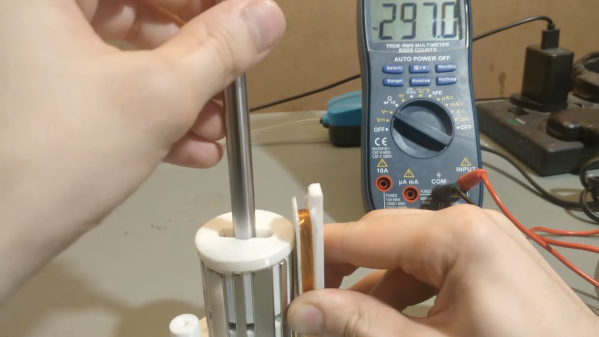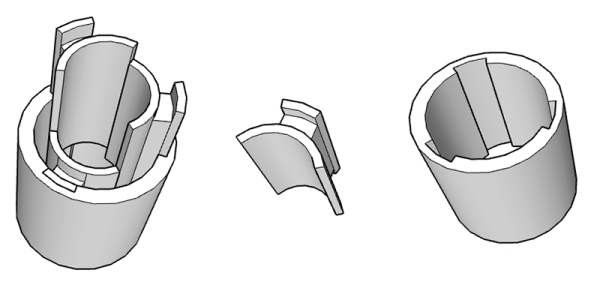Despite the best efforts of the RepRap community over the last twenty years, self-replicating 3D printers have remained a stubbornly elusive goal, largely due to the difficulty of printing electronics. [Brian Minnick]’s fully-printed 3D printer could eventually change that, and he’s already solved an impressive number of technical challenges in the process.
[Brian]’s first step was to make a 3D-printable motor. Instead of the more conventional stepper motors, he designed a fully 3D-printed 3-pole brushed motor. The motor coils are made from solder paste, which the printer applies using a custom syringe-based extruder. The paste is then sintered at a moderate temperature, resulting in traces with a resistivity as low as 0.001 Ω mm, low enough to make effective magnetic coils.
3D printed motor3 Articles
ModuCoil – A Modular Coil For Motor And Generator Projects
While renewable energy offers many opportunities for decentralizing energy production, it can sometimes feel that doing so on a truly local level remains unachievable with increasingly large utility-scale deployments re-centralizing the technology. [AdamEnt] hopes to help others seize the means of energy production with the development of the ModuCoil.
This modular coil is intended to be used in motor and generator applications, and features a 3D printed structure to wind your copper about as well as a series of ferromagnetic machine screws and nuts meant to boost the field strength. This project really emphasizes the rapid part of rapid prototyping with this version 2 of the coil following only a week after the first.
[AdamEnt] only reached a peak of ~600 mV in the short test of a single coil, but is optimistic the current design could hit 1V/coil given a fully wound coil actually affixed to something instead of just held in his hand. It’s definitely early stages, but we think this could be the start of an interesting ecosystem of motor and generator designs.
If you want to learn more about how those big wind turbines work, look here, or you could check out a 3D printed brushless motor, or where all that copper comes from anyway.
Continue reading “ModuCoil – A Modular Coil For Motor And Generator Projects”
Hackaday Prize Entry: 3D Printed Parametric Motrs
If you’re building something that moves, chances are you’ll be using an electric motor. There are tens of thousands of different motors out there, each with their own properties, speeds, torque, and sizes. How do you pick the right motor? Most of the time it’s a highly educated guess, but [Solenoid] has a better idea: just 3D print a motor designed by a calculator that will give you the properties you need
This entry for The Hackaday Prize is just a web-based calculator for motor designs that takes torque, speed, size, or form factor as an input and spits out a complete motor design. Sure, you’ll need to wind coils on a 3D printed frame, but this calculator removes the need to calculate inductance, coil capacitance, and all the other bits needed to construct an efficient motor.
While actual products made in the millions will still be using off the shelf motors, this project is perfect for one-offs. If you want to motorize a telescope mount, this project will design a motor given the power and resolution per steps required. If you want to build a wind turbine, this calculator will put blades right on the outrunner of a brushless motor. It’s a great project, and something we can’t wait to see the results of.


















